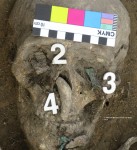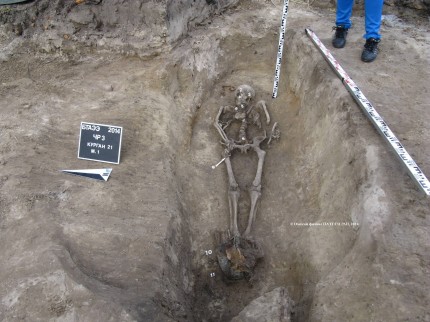Archaeologists excavating a burial mound near Omsk in southwestern Siberia have discovered the intact burial of an impressively large warrior slain in battle around the 11th century A.D. He was powerfully built and 180 centimeters (5’11”) tall. A member of the Ust-Ishim culture, ancestors to the Khanty and Mansi tribes that still inhabit the area today, he was far taller than his comrades; the average height for a male was 160 centimeters (5’3″), so he would have towered over them.
 He was around 40 years old when he died, and the cause of death is clear: his left arm was cut off and buried with him. His shoulder was also freshly broken. These were perimortem battle wounds. He was buried with copious grave goods and careful attention to ritual indicating he was a person of high status in his community. The most remarkable indication of the respect accorded to him was the large bear fang embedded in his nose, a fearsome symbol of strength and power. He also wore a death mask, now mostly decayed because it was made of fabric. Part of the mask were caskets of birch bark over his eye sockets and mouth. Inside the caskets were metal fish figurines whose heads were deliberately snapped off before burial.
He was around 40 years old when he died, and the cause of death is clear: his left arm was cut off and buried with him. His shoulder was also freshly broken. These were perimortem battle wounds. He was buried with copious grave goods and careful attention to ritual indicating he was a person of high status in his community. The most remarkable indication of the respect accorded to him was the large bear fang embedded in his nose, a fearsome symbol of strength and power. He also wore a death mask, now mostly decayed because it was made of fabric. Part of the mask were caskets of birch bark over his eye sockets and mouth. Inside the caskets were metal fish figurines whose heads were deliberately snapped off before burial.
Other grave goods include a round mirror of bronze decorated with abstract swirls that was placed on his chest inside a birch bark cover and a bronze cauldron with the remains of food still inside that was placed at his feet. These served a ritual purpose. Archaeologists believe the mirror was a worn as an amulet and served as a tool used to communicate with the gods, while the cauldron and food were meant to feed the warrior in the afterlife.
Close by were remains of leather and fur, perhaps part of his costume or from the quiver decorations on his arrows.
“We found 25 arrowheads – armour-piercing and diamond shaped, made from metal and bone,” said [archeologist Mikhail Korusenko], a candidate of historical sciences, from the Omsk branch of the Institute of Archeology and Ethnography of the Siberian Branch of the Russian Academy of Sciences.
“Some of them were clearly of military purpose. Behind his skull we found a ringed bridle” – a sign that the warrior was an accomplished horseman.
The arrows are still sharp today.
Mikhail Korusenko on the significance of the find:
“The first studies we made allow us to date the burial to approximately 11th-12th centuries AD. It is a truly unique find which would allow us to fill pages about not only the cultural, but the military history of this part of the region, as we know very little about this particular period of time.”
